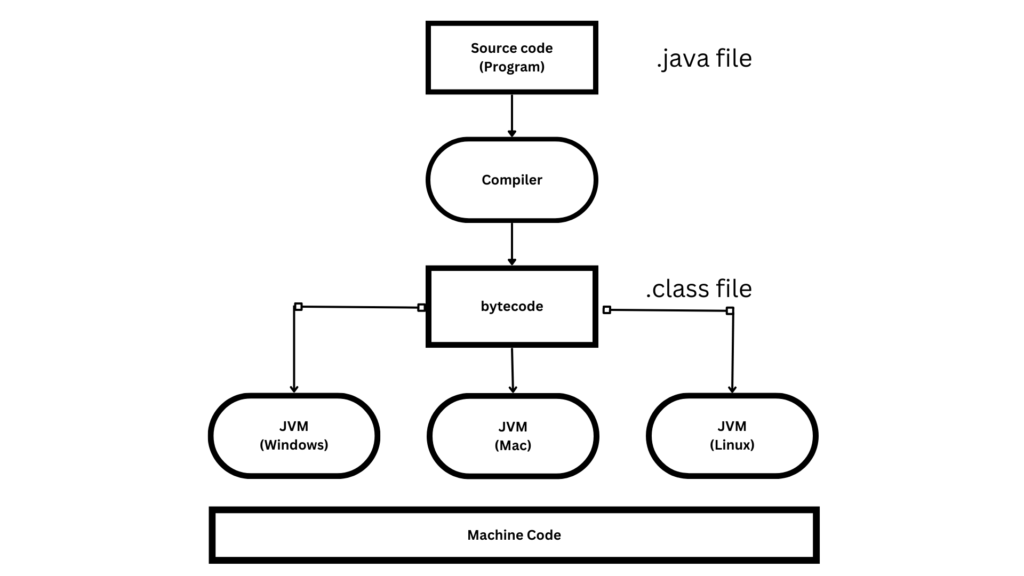Bytecode in Java plays a pivotal role in the realm of programming languages, highlighting Java as a versatile and potent player. This uniqueness is attributed to Java’s compilation process, which intricately involves the generation of bytecode. If you’re a burgeoning programmer or a curious enthusiast, this article serves as your inclusive guide to comprehending the essence of Bytecode in Java. Let’s embark on a journey into its significance, role, and impact on the domain of Java programming.
Contents for Bytecode in Java
What is Bytecode in Java?
Bytecode in Java is an essential concept that bridges the gap between high-level human-readable code and machine-executable instructions. When you write Java code, you create text-based instructions that make sense to humans but not directly to computers. To transform your code into something the computer can understand and execute, Java employs a two-step process: compilation and interpretation.
During compilation, your Java source code is transformed into bytecode. This bytecode is a low-level representation of your code, resembling machine code but independent of any specific hardware or operating system. It’s a set of instructions designed to be executed by the Java Virtual Machine (JVM), a key component in the Java ecosystem.

The Role of Java Virtual Machine (JVM)
The Java virtual machine is an important component of the Java architecture. It acts as an interpreter, executing the bytecode produced by the compilation process. The JVM provides an environment that’s consistent across different platforms, allowing Java programs to run on various systems without modification. This “write once, run anywhere” capability is a hallmark of Java’s design philosophy.
When you run a Java program, the JVM loads the bytecode and translates it into machine-specific instructions that the underlying hardware can execute. This dynamic translation process enables Java programs to achieve a balance between performance and portability.
Advantages of Bytecode in Java
- Portability: Bytecode’s platform-independent nature ensures that a Java program can run on any device or operating system that has a compatible JVM. This portability has been a driving force behind Java’s popularity, especially in enterprise software development.
- Security: Since bytecode is an intermediate representation, the original source code remains hidden from end-users. This provides a layer of security by preventing unauthorized access to the code’s logic.
- Performance: While interpreted languages can be slower than natively compiled languages, the JVM’s Just-In-Time (JIT) compilation optimizes bytecode for execution, often resulting in efficient performance.
- Dynamic Loading: Java programs can dynamically load classes and libraries at runtime, enhancing flexibility and enabling features like plugins and modular development.
The Bytecode Generation Process
- Compilation: When you compile your Java source code, the Java compiler (
javac) transforms it into bytecode. This bytecode is saved in.classfiles, each corresponding to a class in your code. - Classloading: When you run a Java program, the JVM’s classloader loads the required classes into memory. These classes can be part of your program or standard Java libraries.
- Verification: The JVM verifies the loaded bytecode to ensure it adheres to security and structural constraints. This step prevents malicious code from causing harm.
- Execution: The bytecode is interpreted by the JVM or, in some cases, compiled further into native machine code for improved execution speed.
Conclusion
In the world of Java programming, bytecode is the foundation upon which the language’s portability, security, and performance rest. It serves as the intermediary that allows developers to write code once and run it on diverse platforms without modification. The Java Virtual Machine’s role in interpreting and executing bytecode underscores its significance in the Java ecosystem.
As you continue your programming journey, understanding bytecode will provide you with insights into how Java programs function at a deeper level. Whether you’re building desktop applications, mobile apps, or enterprise systems, bytecode remains a core element that enables the seamless execution of your Java code. So, the next time you write Java code, remember that it’s not just for humans but also for the bytecode interpreter that brings your creations to life on the digital stage.



